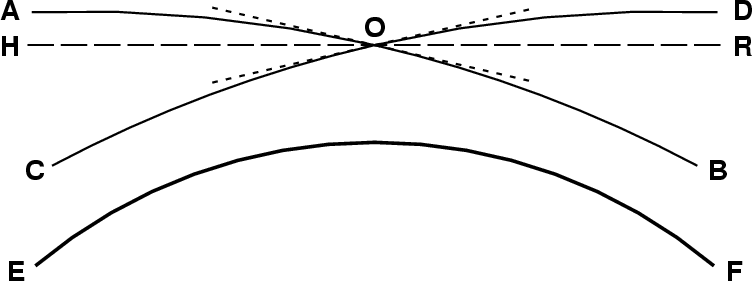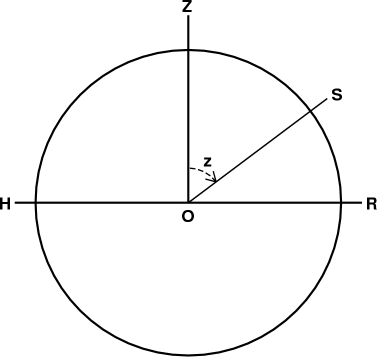Symmetry in Atmospheric Refraction
Introduction
Some of the complexity of refraction phenomena can be reduced by
considerations of symmetry. This page discusses several of these.
Reversibility of rays
Perhaps the simplest symmetry is fundamental to geometrical optics: the
reversibility of rays. I consider reversibility in general
elsewhere;
but there is a particular case in atmospheric refraction that deserves special
attention.
Reversibility connects the paths taken by pairs of rays at equal
altitudes
above and below the
astronomical horizon.
 In this diagram, where EF represents the surface of the Earth,
the rays reaching the observer at O from B and D are
such a pair; note that their tangents at O (i.e., the directions from which
they appear to come) make equal angles with the local horizontal, HOR.
These paths have the same shape; at each height, they have equal slopes.
Essentially, they are the same shape, simply transposed (or
reflected about their lowest point) so as to place the observer on either
the rising or the falling half of the curve — as their extensions on the
left side of the diagram show.
In this diagram, where EF represents the surface of the Earth,
the rays reaching the observer at O from B and D are
such a pair; note that their tangents at O (i.e., the directions from which
they appear to come) make equal angles with the local horizontal, HOR.
These paths have the same shape; at each height, they have equal slopes.
Essentially, they are the same shape, simply transposed (or
reflected about their lowest point) so as to place the observer on either
the rising or the falling half of the curve — as their extensions on the
left side of the diagram show.
Symmetry of refracted rays
This immediately brings up the symmetry of the ray path itself.
All refracted rays in a horizontally-layered atmosphere are symmetrical
about their lowest point.
(Note that “horizontally-layered” means that
the refractive index is a
function only of the distance r from the center of curvature of the
atmosphere.)
 As the ray AB is horizontal at its lowest point, m, the zenith distance there
is 90°, which makes the sin z factor in the
refractive invariant
n r sin z equal to unity.
(z is the local zenith distance at any point along the refracted
ray.)
Then the invariant is simply the value of n r at the minimum.
As the ray AB is horizontal at its lowest point, m, the zenith distance there
is 90°, which makes the sin z factor in the
refractive invariant
n r sin z equal to unity.
(z is the local zenith distance at any point along the refracted
ray.)
Then the invariant is simply the value of n r at the minimum.
Note that the even symmetry of the sine function about 90° makes
sin (90 + x) = sin (90 − x).
Consequently, the invariant says that the curve has equal but opposite
slopes on either side of the minimum, at the same value of r.
This aspect of symmetry can be used to derive the
magnification theorem.
Coefficients in the series expansion
One of the most historically important devices in the theory of
refraction is the expansion of refraction in powers of (tan Z), where
Z is the zenith distance of the ray at the observer.
One reason why this expansion is so useful is that it involves only odd
powers of (tan Z); the rapid decrease in the coefficients of the
terms make all the high-order terms negligible out to considerable zenith
distances.
So, for many purposes, the
flat-Earth approximation involving only the
first term is good enough out to 60° or so; and beyond that,
Oriani's theorem
shows that the refraction out to 75 or 80° — which is to say, the
whole of the sky over which image quality is good enough to allow accurate
positional measurements —
is well represented by just the first two terms, which involve only
the temperature and pressure at the observer, and not the detailed
atmospheric structure.
(On the other hand, this same argument shows that
Cassini's model, which is even more
accurate, is perfectly valid in this same region.)
But why are the coefficients of the even powers all exactly zero?
This is not immediately obvious; and indeed,
Bradley
discovered empirically that the coefficient of
tan2Z was negligible, and then simply assumed it was
zero without proof. And even
Ivory
goes to the trouble of proving it by tediously evaluating the integrals
involved in the coefficients. But we can easily prove it without
evaluating any integrals.

The diagram at the right shows a complete vertical circle. The observer
is at O, with zenith at Z, and HOR is the observer's horizon. S is a
star, whose zenith distance is z, measured positive from Z toward R.
But then zenith distances should be negative when measured from Z
toward H; objects in the left half of the diagram must have negative
zenith distances — and likewise, negative refractions. (Perhaps the
inconvenience of such negative angles explains why they are not normally
used.)
Astronomers are so accustomed to considering zenith distances as positive
that the continuity and smoothness of the refraction through the zenith
are usually overlooked. But if we consider the whole vertical circle,
regarding Z as positive on one side of the zenith and negative on the other,
it's obvious that the refraction is an odd function of Z.
As (tan Z) is also an odd function of Z, the only way the refraction
can be expanded in powers of (tan Z) is for only odd powers to
appear; the even powers of (tan Z) would be even functions, but the
even part of the refraction must vanish.
So the coefficients of the even powers of the tangent must also vanish.
Copyright © 2002 – 2003, 2005, 2006, 2010, 2012 Andrew T. Young
Back to the ...
astronomical refraction page
or the
GF pictures page
or the
GF home page
 In this diagram, where EF represents the surface of the Earth,
the rays reaching the observer at O from B and D are
such a pair; note that their tangents at O (i.e., the directions from which
they appear to come) make equal angles with the local horizontal, HOR.
These paths have the same shape; at each height, they have equal slopes.
Essentially, they are the same shape, simply transposed (or
reflected about their lowest point) so as to place the observer on either
the rising or the falling half of the curve — as their extensions on the
left side of the diagram show.
In this diagram, where EF represents the surface of the Earth,
the rays reaching the observer at O from B and D are
such a pair; note that their tangents at O (i.e., the directions from which
they appear to come) make equal angles with the local horizontal, HOR.
These paths have the same shape; at each height, they have equal slopes.
Essentially, they are the same shape, simply transposed (or
reflected about their lowest point) so as to place the observer on either
the rising or the falling half of the curve — as their extensions on the
left side of the diagram show.
 As the ray AB is horizontal at its lowest point, m, the zenith distance there
is 90°, which makes the sin z factor in the
As the ray AB is horizontal at its lowest point, m, the zenith distance there
is 90°, which makes the sin z factor in the
